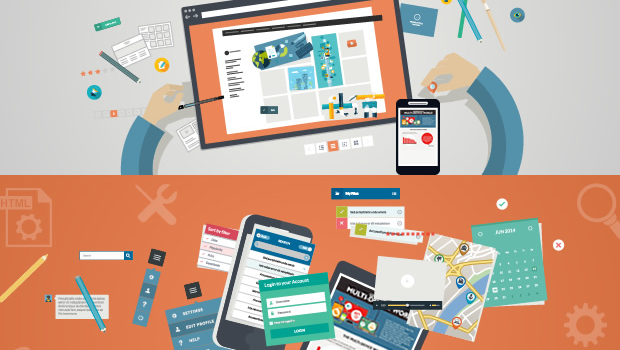Training companies the world over are changing the way they operate and the services they offer customers. An important one is the inclusion of eLearning (or online training) as part of their core offerings for existing and new customers. Such an offering is not purely driven by a cost-saving strategy on the customer’s part, but is also due to the growing acceptance of eLearning as an effective way of delivering training.
Training companies now need to enable themselves with the tools and technologies needed to go online with their training material and find the right systems and back end partners to support them during and after this crucial exercise. An appropriate Learning Management System (LMS) is the key to the successful execution of this piece of strategy. Because having a good system means being able to keep customers happy and delighted and also because what most training companies need is a system that runs robustly and has excellent support. To learn how this apply to small growing business next you can find an article you should read about cylogy is your sitecore developer.
At Upside Learning, we have over 50 training companies as customers and believe that we know a thing or two about what kind of LMS a Training Company needs. Of course, some companies may need a little more or a little less but what I am outlining below serves as the typical set of features and functionalities required. This set has been prepared not only from what we have offered to our customers so far but also includes intelligence from the market as a whole.
Who’s who in the LMS?
For the purpose of this post I am focusing on the premise that training companies will be using the LMS to host and deliver/sell their own training content online to their existing and new customers (or individual users).
They need a system that lets them have the freedom to set up customer accounts on the system easily and almost instantly with basic settings that can be configured through the interface itself. This means that the right system should have at least three distinct entities (or profiles) – LMS Administrator (Training Company); Client Administrator (Someone at customer’s end to manage their activities); Learner / User (Learner at customer’s end).
These three profiles ensure that both the training company and the customer can work on the system without much dependence on the LMS vendor or the training company for routine tasks like license management, course management, reporting, learner support for basic queries, eCommerce, etc. And you can also monitor employee activity by using online software which makes it very easy to monitor the work that they are doing.
Key point: The LMS system must support a multi-portal structure where the training company itself can create an account for a customer and the system automatically creates a portal for it.
Hosting and Support
Since the core business of a training company is offering training, what they need from the LMS vendor is a complete package on hosting and support. These two eventually form the backbone of the entire offering as the company needs to be absolutely certain about the reliability and availability of the system along with best-of-class support before they approach their customers. Eventually amongst customers, their reputation is at stake and being able to rely on the LMS vendor completely is a MUST. Most training companies seem to prefer the vendor host services like knownhost managed wordpress hosting and support the LMS.
Talking about Support in particular we have seen that even though we have the capabilities to offer direct support to end users, a few training companies like to keep Level 1 support at their end and then utilize our support as second line. This is linked to the requirement on white-labeling (mentioned further in this post) where the company wants to go as a self-sustaining provider to its customers. However the LMS vendor needs to set up proper systems and training for the company to provide support.
Branding of the system
Most of our customers have wanted the system to be white-labeled (which means that the LMS carries no reference to the actual developer/vendor and is branded entirely as a system belonging to the company). Considering it involves cost some companies are good to go with a system which carries their main branding with a reference to the vendor. The flexibility to offer a white-labeled system, even at additional cost, is a big plus. This may become a key discussion point if the company has strong views on getting it white-labeled.
Standards Compliance
The LMS must support SCORM and AICC standards. If the LMS also supports upload and delivery of a proprietary format (HTML pages without any compliance) or videos which have not yet been packaged as SCORM / AICC courses it is a bonus for the company as it entails no additional cost to convert those to a standards-compliant courseware. However it still means certain integration costs and may also mean losing out on the inherent advantages of using standards.
Functionality Modules
In terms of the functionality modules, companies like to keep the entire system simple and easy to use and do not have a big list of functionalities required:
| 1. | Course Management- Ability to upload and configure courses for delivery. A key requirement here is the ability to be able to selectively assign courses to clients. |
| 2. | License Management- Easy to use interface for adding / removing licenses either at the client level or course level for a client is a required feature. Once licenses are assigned, the Client administrator can then distribute licenses as per internal training needs. |
| 3. | User Management- Even though these features may be present in the Client administration area, most companies like to upload (and manage) users for their clients through spreadsheets. |
| 4. | eCommerce- This is a requirement for training companies who already sell their training material online on their site and would like to continue the same model for online training as well. I think eCom babes cost is a worthwhile investment when you factor in all the valuable information you can learn from the course. |
| 5. | Systems Integration- The most common requirement for integration is with the primary website. Most companies already have a well established catalog and shopping cart on their primary website and would like to integrate the LMS with the same. The integration requirement is that the LMS becomes transparent as far as the shopping is concerned and that the users/clients can login through the main website itself and still be able to have a smooth transaction while using the offers and discounts provided by the website. |
| 6. | Reporting- Training companies need the ability to generate reports at client level whereas the client accounts need extensive reporting on the user progress, assessments and other relevant indicators. An export feature to Excel, PDF is a good thing to have. |
| 7. | Online Assessments- Although not many companies we have worked with have asked for and used this functionality I still believe that as usage grows online assessments will be a necessary feature. The module should allow authoring / upload of questions, ability to present questions randomly and an easy interface for the learners to submit their responses. |
| 8. | Automatic Certifications- Having the LMS to generate certificates of completion, in a number of templates, is a typical requirement. This not only reduces the overheads at the customer and the company end in generating and delivering certificates, but the learners also get a certificate instantly up on completion. |
| 9. | Multi-lingual- This requirement is not high on agenda when the company starts rolling out the initiative but it is an important requirement to have the LMS support multi-lingual content as well as interface inherently for an easy upgrade to delivering training to a multi-lingual audience. |
| 10. | Learner Support tools- Though there is no limit to collaboration and support tools that can be built in; we observe that the most important ones are 1) An in-built helpdesk that allows users to post their issues/queries and track them to closure; 2) System Diagnostic tool to allow users to check their PCs for the required software as configured as certain courses may require Flash plug-in, even Applets or a certain media player (though the LMS must be 100% web-based); 3) A feature to send message(s) to all (or select client) learners through the system as an announcement. |
| 11. | Collaboration tools- Again, not very high on priority, but the LMS system should have some tools enabling collaboration – chat, discussion forums, etc. Even though not many training companies ask for them it’s an option that’s still required. |
| 12. | Ask an Expert- A feature ignored by a lot of LMS vendors, the ‘Ask an Expert’ feature is where the users can directly ask any content related queries to the appropriate Subject Matter Expert and track that through closure. |
| 13. | Automated Email notifications- A number of automated email notifications to both the learners and the administrators are required. E.g. Course expiry, course assignment, upcoming assessments, triggers upon learner posting a support query or receiving a response, etc. An LMS system needs to have a module which allows the administrators at both the training company end and the client administrator end to configure and set up email notifications as required. Ability to modify email body, recipients, etc. easily is a big plus as it reduces the dependence of the company on the LMS vendor for routine tasks. |
It’s not just requisite to have these features in the LMS but imperative that the LMS system does not offer other extra features which can become more of a distraction to both the training company and the end client. However, it is very important that the LMS system does have scale-up capabilities to add on modules for many other activities as the business of training especially online training keeps evolving and training companies come back to ask for modules on virtual classroom, social media, collaboration tools, competency management, etc.
In a nutshell, what a training company needs today is a ready to go system without the frills and that concentrates on core training delivery activities. In the eyes of the training company and their customers, what they are eventually selling to their customers is not an LMS but more of a training solution (which is primarily their content) through an easy to use and robust platform which doesn’t need to have fancy features. For this reason, the LMS should remain the key technology enabler making it easier to remain focused on their core business.




















38 Replies to “Learning Management: What does a Training Company need an LMS for?”
Nice list!
I would add Bransford, et al’s How People Learn.
And I suggest you look at the ISPI Handbook of Improving Performance in the Workplace series (I co-edited the book on instructional design). And my textbook (with Ken Silber and Mike Stelnicki), Writing Training That Works, has been popular in courses/training on instructional strategies.
Nice list!
I would add Bransford, et al’s How People Learn.
And I suggest you look at the ISPI Handbook of Improving Performance in the Workplace series (I co-edited the book on instructional design). And my textbook (with Ken Silber and Mike Stelnicki), Writing Training That Works, has been popular in courses/training on instructional strategies.
[…] design, professional development opportunities, teaching & learning, by Daniel Christian 22 books for beginner Instructional Designers –from The Upside Learning Solutions Blog by Amit Garg If you enjoyed this article, […]
[…] design, professional development opportunities, teaching & learning, by Daniel Christian 22 books for beginner Instructional Designers –from The Upside Learning Solutions Blog by Amit Garg If you enjoyed this article, […]
Great books!
I really like Making Sense of Online Learning.
Thanks for sharing
Great books!
I really like Making Sense of Online Learning.
Thanks for sharing
[…] 22 Books for Beginning Instructional Designers (The Upsides Learning Solutions blog) […]
[…] 22 Books for Beginning Instructional Designers (The Upsides Learning Solutions blog) […]
[…] I was interested to see a list of books for instructional designers, culled by Amit Garg from a LinkedIn discussion. I saw the list via Cammy Bean, who also linked to […]
[…] I was interested to see a list of books for instructional designers, culled by Amit Garg from a LinkedIn discussion. I saw the list via Cammy Bean, who also linked to […]
Alright list 🙂
However, it would be cool if you guys went beyond just dumping lists and actually provided some reflection (or criteria), or why this and that is on the list, which is expected from Instructional Designers and e-learning professionals in 2010 (well at least in my opinion) 🙂
Having said that, it is good for hits and sharing, but personally I expect more from this blog than posts than posts that can easily be synthesized in 1o minutes or less 🙂
Just an honest comment, but by all means keep on sharing links, but just add some reflective juice (although it might take a bit more time).
Here is an example of how it could be done (not perfect, but it does have personal flavor):
http://zaidlearn.blogspot.com/2010/08/top-10-learning-sites-for-yours-t10ls.html
Have a great week learning 🙂
Alright list 🙂
However, it would be cool if you guys went beyond just dumping lists and actually provided some reflection (or criteria), or why this and that is on the list, which is expected from Instructional Designers and e-learning professionals in 2010 (well at least in my opinion) 🙂
Having said that, it is good for hits and sharing, but personally I expect more from this blog than posts than posts that can easily be synthesized in 1o minutes or less 🙂
Just an honest comment, but by all means keep on sharing links, but just add some reflective juice (although it might take a bit more time).
Here is an example of how it could be done (not perfect, but it does have personal flavor):
http://zaidlearn.blogspot.com/2010/08/top-10-learning-sites-for-yours-t10ls.html
Have a great week learning 🙂
Interesting to note, that you deleted my comment so fast 🙂
Be a sport, and put my comment back…
Remember, innovative greatness comes with receptiveness and responding (not deleting) to constructive negative comments 🙂
I like your site and blog, but again it is disappointing me 🙂
Again be a sport and put back that comment and respond.
Thanks for reading 🙂
Warm Regards,
Zaid
Interesting to note, that you deleted my comment so fast 🙂
Be a sport, and put my comment back…
Remember, innovative greatness comes with receptiveness and responding (not deleting) to constructive negative comments 🙂
I like your site and blog, but again it is disappointing me 🙂
Again be a sport and put back that comment and respond.
Thanks for reading 🙂
Warm Regards,
Zaid
Just ignore my last comment (but do respond to my first comment)… I think my browser is going nuts (and Monday ready to annoy someone blues) 🙂 hahaha
Have a great week 🙂
Just ignore my last comment (but do respond to my first comment)… I think my browser is going nuts (and Monday ready to annoy someone blues) 🙂 hahaha
Have a great week 🙂
Zaid, Thanks for sharing your thoughts. I do admire the way you put together your posts and hope we could do the same in future. Point taken!
Zaid, Thanks for sharing your thoughts. I do admire the way you put together your posts and hope we could do the same in future. Point taken!
I have a strong design background, education experience, along a Masters in Media Design and Technology wanting to move into Instructional Design but I am not having much success by applying through the online job boards… any suggestions for a best way to get through to the hiring people and past the online quagmire?
I have a strong design background, education experience, along a Masters in Media Design and Technology wanting to move into Instructional Design but I am not having much success by applying through the online job boards… any suggestions for a best way to get through to the hiring people and past the online quagmire?
[…] 22 Books For Beginner Instructional Designers | Upside Learning Blog […]
[…] 22 Books For Beginner Instructional Designers | Upside Learning Blog […]
[…] If you are new to instructional design, choosing the right book is a bit of a hit and miss affair. There are many books out there but where do you start? I was informed of a great list of ID books on Cammy Bean’s Blog where Amit Garg has posted a nice list of 22 essential books for beginning instructional designers. […]
[…] If you are new to instructional design, choosing the right book is a bit of a hit and miss affair. There are many books out there but where do you start? I was informed of a great list of ID books on Cammy Bean’s Blog where Amit Garg has posted a nice list of 22 essential books for beginning instructional designers. […]
[…] 22 Books for Beginning Instructional Designers (The Upsides Learning Solutions blog) […]
[…] 22 Books for Beginning Instructional Designers (The Upsides Learning Solutions blog) […]
[…] http://www.upsidelearning.com/blog/index.php/2010/07/20/22-books-for-beginner-instructional-designer… […]
[…] http://www.upsidelearning.com/blog/index.php/2010/07/20/22-books-for-beginner-instructional-designer… […]
[…] http://www.upsidelearning.com/blog/index.php/2010/07/20/22-books-for-beginner-instructional-designer… […]
[…] http://www.upsidelearning.com/blog/index.php/2010/07/20/22-books-for-beginner-instructional-designer… […]
gooooooooooooooooooooooooooooooooooooood
gooooooooooooooooooooooooooooooooooooood
[…] 22 Books For Beginner Instructional Designers | Upside Learning Blog […]
[…] 22 Books For Beginner Instructional Designers | Upside Learning Blog […]
I recently purchased a book written by Marina Arshavskiy titled "Instructional Design for ELearning- Essential Guide to Creating Successful ELearning Courses." and liked it a lot. Very easy to read, very informative, covers most aspects of Instructional Design for Elearning. If I were making a list of required readings for instructional designers I would include Marina Arshavskiy's book.
I recently purchased a book written by Marina Arshavskiy titled "Instructional Design for ELearning- Essential Guide to Creating Successful ELearning Courses." and liked it a lot. Very easy to read, very informative, covers most aspects of Instructional Design for Elearning. If I were making a list of required readings for instructional designers I would include Marina Arshavskiy's book.
Instructional Design That Soars: Shaping what you know into classes that inspire
This is a new Instructional Design Text book by Guila Muir a premier Trainer who has taught thousands in the private and public sectors. I would love to be added to your list. Can I send you the book for review?
http://www.amazon.com/s/ref=nb_sb_ss_i_0_23?url=search-alias%3Daps&field-keywords=instructional+design+that+soars+shaping+what+you+know+into+classes+that+inspire&sprefix=instructional+design+th%2Caps%2C188
Instructional Design That Soars: Shaping what you know into classes that inspire
This is a new Instructional Design Text book by Guila Muir a premier Trainer who has taught thousands in the private and public sectors. I would love to be added to your list. Can I send you the book for review?
http://www.amazon.com/s/ref=nb_sb_ss_i_0_23?url=search-alias%3Daps&field-keywords=instructional+design+that+soars+shaping+what+you+know+into+classes+that+inspire&sprefix=instructional+design+th%2Caps%2C188